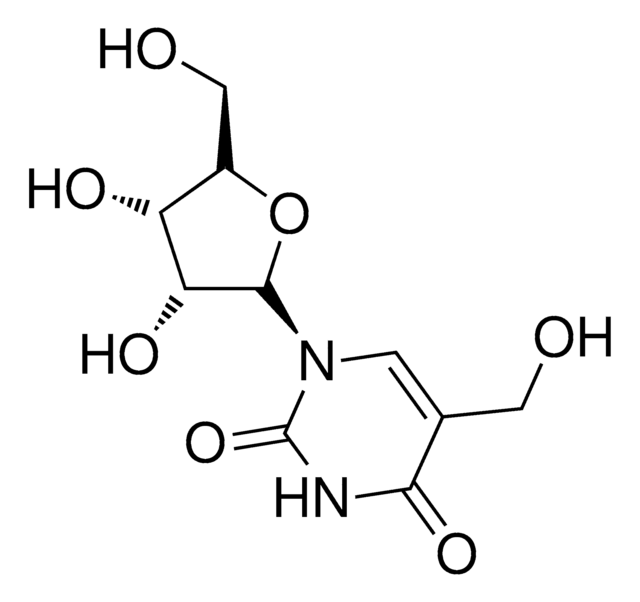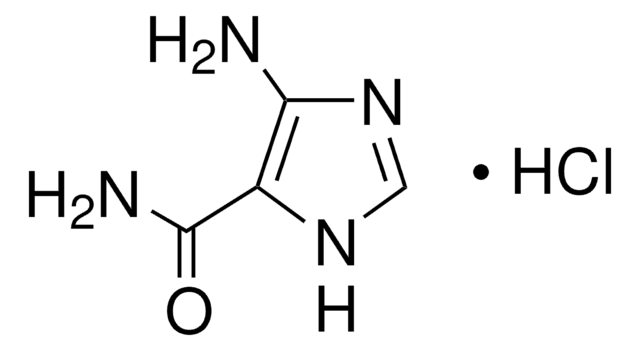All Photos(1)
About This Item
Empirical Formula (Hill Notation):
C5H6N2O3
CAS Number:
Molecular Weight:
142.11
EC Number:
MDL number:
UNSPSC Code:
12352100
PubChem Substance ID:
NACRES:
NA.22
Recommended Products
assay
97%
form
powder
mp
>300 °C (lit.)
SMILES string
[H]O[H].OCC1=CNC(=O)NC1=O
InChI
1S/C5H6N2O3/c8-2-3-1-6-5(10)7-4(3)9/h1,8H,2H2,(H2,6,7,9,10)
InChI key
JDBGXEHEIRGOBU-UHFFFAOYSA-N
Storage Class
11 - Combustible Solids
wgk_germany
WGK 3
flash_point_f
Not applicable
flash_point_c
Not applicable
ppe
Eyeshields, Gloves, type N95 (US)
Certificates of Analysis (COA)
Search for Certificates of Analysis (COA) by entering the products Lot/Batch Number. Lot and Batch Numbers can be found on a product’s label following the words ‘Lot’ or ‘Batch’.
Already Own This Product?
Find documentation for the products that you have recently purchased in the Document Library.
Customers Also Viewed
Rafal Rozalski et al.
Free radical research, 38(11), 1201-1205 (2004-12-29)
In order to eliminate the possibility that diet may influence urinary oxidative DNA lesion levels, in our experiments we used a recently developed technique involving HPLC pre-purification followed by gas chromatography with isotope dilution mass spectrometric detection. This methodology was
Masaki Hori et al.
Nucleic acids research, 31(4), 1191-1196 (2003-02-13)
The oxidation and deamination of 5-methylcytosine (5mC) in DNA generates a base-pair between 5-hydroxymethyluracil (5hmU) and guanine. 5hmU normally forms a base-pair with adenine. Therefore, the conversion of 5mC to 5hmU is a potential pathway for the generation of 5mC
Hideharu Hashimoto et al.
Nucleic acids research, 40(11), 4841-4849 (2012-03-01)
Cytosine residues in mammalian DNA occur in at least three forms, cytosine (C), 5-methylcytosine (M; 5mC) and 5-hydroxymethylcytosine (H; 5hmC). During semi-conservative DNA replication, hemi-methylated (M/C) and hemi-hydroxymethylated (H/C) CpG dinucleotides are transiently generated, where only the parental strand is
Jane E A Wibley et al.
Molecular cell, 11(6), 1647-1659 (2003-06-25)
Cytosine deamination is a major promutagenic process, generating G:U mismatches that can cause transition mutations if not repaired. Uracil is also introduced into DNA via nonmutagenic incorporation of dUTP during replication. In bacteria, uracil is excised by uracil-DNA glycosylases (UDG)
Yoke W Kow
Free radical biology & medicine, 33(7), 886-893 (2002-10-04)
Deamination of DNA bases can occur spontaneously, generating highly mutagenic lesions such as uracil, hypoxanthine, and xanthine. When cells are under oxidative stress that is induced either by oxidizing agents or by mitochondrial dysfunction, additional deamination products such as 5-hydroxymethyluracil
Our team of scientists has experience in all areas of research including Life Science, Material Science, Chemical Synthesis, Chromatography, Analytical and many others.
Contact Technical Service











